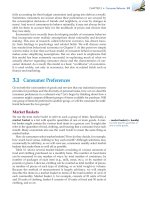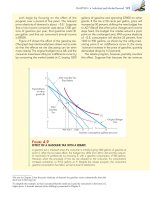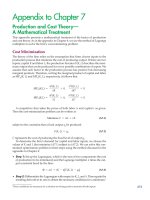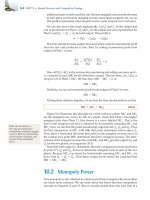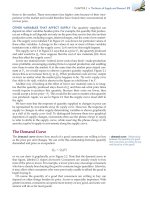(8th edition) (the pearson series in economics) robert pindyck, daniel rubinfeld microecon 296
Bạn đang xem bản rút gọn của tài liệu. Xem và tải ngay bản đầy đủ của tài liệu tại đây (90.89 KB, 1 trang )
CHAPTER 7 • The Cost of Production 271
EXERCISES
1. Joe quits his computer programming job, where he was
earning a salary of $50,000 per year, to start his own
computer software business in a building that he owns
and was previously renting out for $24,000 per year. In
his first year of business he has the following expenses:
salary paid to himself, $40,000; rent, $0; other expenses,
$25,000. Find the accounting cost and the economic
cost associated with Joe’s computer software business.
2. a. Fill in the blanks in the table below.
b. Draw a graph that shows marginal cost, average
variable cost, and average total cost, with cost on
the vertical axis and quantity on the horizontal axis.
3. A firm has a fixed production cost of $5000 and a
constant marginal cost of production of $500 per unit
produced.
a. What is the firm’s total cost function? Average cost?
b. If the firm wanted to minimize the average total
cost, would it choose to be very large or very small?
Explain.
4. Suppose a firm must pay an annual tax, which is a fixed
sum, independent of whether it produces any output.
a. How does this tax affect the firm’s fixed, marginal,
and average costs?
b. Now suppose the firm is charged a tax that is proportional to the number of items it produces. Again,
how does this tax affect the firm’s fixed, marginal,
and average costs?
5. A recent issue of Business Week reported the following:
union contracts obligate them to pay many workers even if they’re not working.
When the article discusses selling cars “at a loss,” is it
referring to accounting profit or economic profit? How
will the two differ in this case? Explain briefly.
6. Suppose the economy takes a downturn, and that
labor costs fall by 50 percent and are expected to stay
at that level for a long time. Show graphically how this
change in the relative price of labor and capital affects
the firm’s expansion path.
7. The cost of flying a passenger plane from point A to
point B is $50,000. The airline flies this route four times
per day at 7 AM, 10 AM, 1 PM, and 4 PM. The first and
last flights are filled to capacity with 240 people. The
second and third flights are only half full. Find the
average cost per passenger for each flight. Suppose
the airline hires you as a marketing consultant and
wants to know which type of customer it should try to
attract—the off-peak customer (the middle two flights)
or the rush-hour customer (the first and last flights).
What advice would you offer?
8. You manage a plant that mass-produces engines by
teams of workers using assembly machines. The technology is summarized by the production function
During the recent auto sales slump, GM, Ford,
and Chrysler decided it was cheaper to sell cars
to rental companies at a loss than to lay off workers. That’s because closing and reopening plants is
expensive, partly because the auto makers’ current
UNITS OF
OUTPUT
FIXED
COST
VARIABLE
COST
TOTAL
COST
0
100
1
125
2
145
3
157
4
177
5
202
6
236
7
270
8
326
9
398
10
490
MARGINAL
COST
q = 5 KL
where q is the number of engines per week, K is the
number of assembly machines, and L is the number
of labor teams. Each assembly machine rents for
r ϭ $10,000 per week, and each team costs w ϭ $5000
per week. Engine costs are given by the cost of labor
teams and machines, plus $2000 per engine for raw
AVERAGE
FIXED COST
AVERAGE
VARIABLE COST
AVERAGE
TOTAL COST

